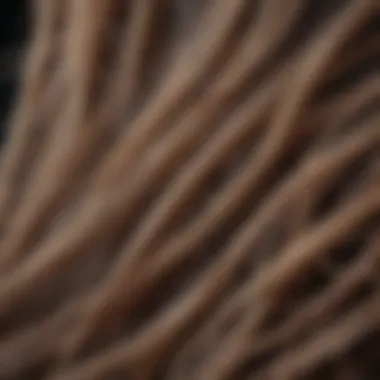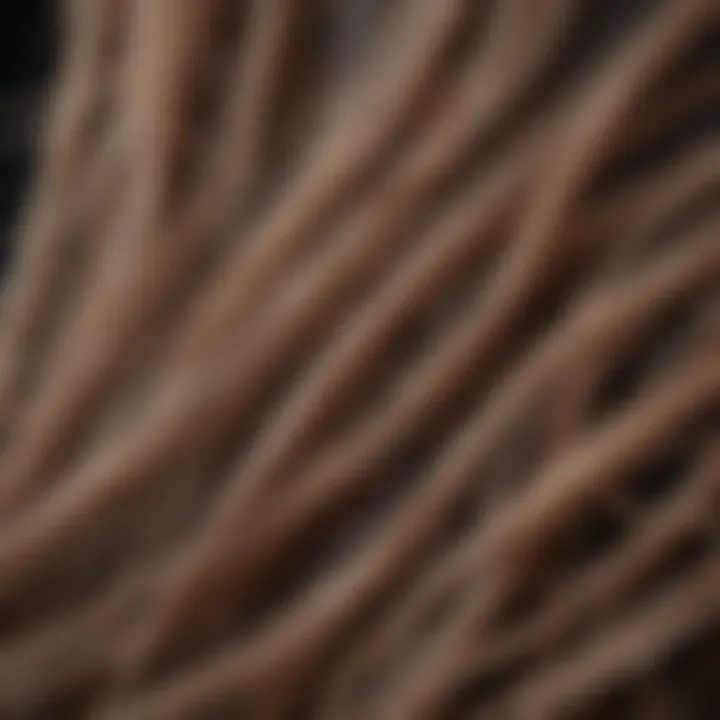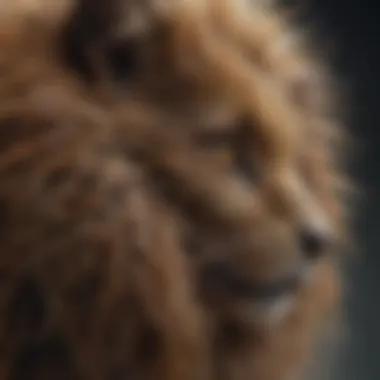Exploring the Complex World of Animal Hair


Article Overview
Purpose of the Article
This article seeks to explore the intricate aspects of animal hair, dissecting its structure, function, and various applications. By examining the biological characteristics of hair, we aim to illuminate its evolutionary significance and functional roles across animal species. Moreover, we will shed light on how animal hair finds application in diverse fields including textiles, environmental science, and even forensic investigations. This examination will help readers appreciate the multifaceted nature of what might at first seem like a simple biological feature.
Relevance to Multiple Disciplines
Animal hair holds relevance in a multitude of fields. In biology and ecology, understanding the different structures of hair can reveal adaptations and survival strategies. In the textile industry, fibers from animal hair, such as wool from sheep or cashmere from goats, contribute significantly to material diversity and quality. Forensic scientists utilize animal hair as trace evidence in crime scenes, which can assist in identifying both suspects and victims. This interconnectedness showcases how animal hair transcends disciplinary boundaries, impacting various domains of study and practice.
Research Background
Historical Context
The study of animal hair is not entirely new. Historical texts reference the use of animal fibers in human clothing and tools. Over time, various cultures have developed techniques for extracting and utilizing animal hair. From the fine silk produced by silkworms to the sturdy furs valued in colder regions, these materials have shaped human societies significantly. Modern scientific inquiry has expanded this knowledge, contributing to fields like genetics and material science.
Key Concepts and Definitions
- Structure of Animal Hair: Refers to the anatomical composition and arrangement of hair fibers, including the cuticle, cortex, and medulla.
- Thermoregulation: The process by which animals maintain their body temperature, often facilitated by the insulating properties of their hair.
- Applications in Textiles: The use of animal fibers in creating clothing, upholstery, and other fabric-based products.
- Forensic Analysis: The examination of hair samples to draw conclusions in criminal investigations.
Understanding these concepts lays the foundation for further discussion on how animal hair functions in both ecological and practical contexts. The complexity of hair structures across species highlights evolutionary adaptations. This article will build on that understanding, leading to discussions on specific applications and their implications.
Preface to Animal Hair
Animal hair serves as a fundamental component of many species, playing key roles in both their physiological and ecological contexts. Understanding animal hair offers insights into the broader aspects of biology, ecology, and even sociology. This article aims to elucidate the various dimensions of animal hair, starting with its biological underpinnings and moving through its applications in industries and science.
Examining animal hair allows researchers and professionals to grasp how it contributes to thermal regulation, protection, and sensory functions in various species. Such knowledge is not only essential for biologists but also for those in textile industries and forensic science. The intricate structure of hair and its compositional components—primarily keratin—merit attention, especially regarding how they affect the properties of hair in different environments.
Some of the benefits of studying animal hair include:
- Understanding biological diversity: Each species exhibits unique hair structures that serve specific functions in their habitats.
- Innovation in materials: Insights from animal hair can lead to advances in sustainable textiles and innovative applications in various industries.
- Forensic science applications: The examination of animal hair can provide critical information in crime scene investigations.
Considering these various elements, the investigation into animal hair is a multifaceted endeavor that taps into biology, ecology, and practical applications. We begin our exploration by defining animal hair and providing an overview of its significance.
Biological Structure of Animal Hair
The biological structure of animal hair is pivotal to understanding its multifaceted roles across various species and applications. It encompasses not only the composition and anatomy of hair but also the evolutionary adaptations that influence its characteristics. This section aims to shed light on these essential elements, which are crucial for comprehending how hair functions biologically and practically.
Anatomy of Hair Follicles
The anatomy of hair follicles is fundamental to the study of animal hair. Each hair follicle originates in the skin and serves as the growth centre for hair. A typical hair follicle consists of several parts:
- Hair bulb: This is the lower part where cell division occurs, leading to the production of hair.
- Dermal papilla: Located at the base of the bulb, this structure contains blood vessels that supply nutrients to the growing hair.
- Outer root sheath: This layer protects the hair follicles.
Understanding the structure and function of hair follicles allows researchers to explain why hair varies between species. For instance, certain adaptations enable animals to thrive in their environments, showcasing the evolutionary significance of these structures. Furthermore, the health of hair follicles is directly tied to the overall health of the animal, affecting growth, thickness, and condition of the hair.
Composition of Hair
Animal hair is primarily composed of proteins, lipids, and pigments. The key aspect of the composition that warrants attention is keratin, which plays an indispensable role in forming hair.
Keratin: The Key Protein
Keratin is a fibrous protein that provides strength and structure to animal hair. It is characterized by its durability and resilience, making it one of the most robust materials produced by animals. This characteristic is especially vital for animals in survival contexts, where hair or fur must withstand environmental stresses. Keratin has a unique feature: it exists in various forms, known as alpha and beta keratin.
- Alpha keratin: Primarily found in mammals; it is softer and more pliable.
- Beta keratin: Common in reptiles, it is harder and provides additional protective properties.
The advantages of keratin in animal hair include its strength and ability to resist damage, making it a crucial component of protective structures against elements and harm.
Pigmentation Agents
Pigmentation agents in animal hair contribute to its color and pattern, which can have social or ecological implications. Melanin is the primary pigment responsible for coloration in hair. Melanin not only provides diverse hues but also offers protection against ultraviolet radiation.
The significance of pigmentation agents extends beyond aesthetics. They can influence an animal's interactions and behaviors, impacting their ability to camouflage or attract mates. The unique feature of these agents is their ability to vary in concentration, which leads to a broad spectrum of colors across species.
In summary, the biological structure of animal hair, particularly the anatomy of hair follicles and the composition involving keratin and pigmentation agents, forms the basis for understanding the functional significance of hair. This understanding is crucial for applications ranging from textiles to ecological studies. The detailed examination helps in recognizing the versatility and value of animal hair in both biological and applied contexts.


Types of Animal Hair
Understanding the types of animal hair is crucial for comprehending its diverse functions and applications. Each type plays a specific role in the life of an animal, influencing not only their health and well-being but also their interactions with the environment. The significance of these differences becomes even more apparent when considering how they affect human fields such as textile manufacturing, agriculture, and even forensic science.
Guard Hair
Guard hair is the outermost layer of fur found on many mammals. This hair is generally coarser and longer than other types of hair and serves multiple purposes. It protects the underfur from moisture and dirt, acting as a shield that keeps the softer hairs beneath safe. The texture and length of guard hair can vary significantly among species, adapted to different habitats. For instance, animals in arctic regions have longer guard hairs, which provide insulation against harsh weather.
Moreover, guard hairs often contribute to the animal’s camouflage. Many species have guard hairs that match their surroundings, thus helping them evade predators. In some instances, these hairs can even assist in communication, indicating health and vitality to potential mates.
Underfur
Underfur consists of finer, shorter hairs found beneath the guard hair. This layer is essential for insulation, helping animals maintain their body temperature in varying climates. Underfur traps air close to the skin, creating a barrier against the cold. In many species, the density of underfur increases during colder months. This natural process showcases the adaptability of animals to their environments.
In addition to thermal regulation, underfur also plays a role in moisture repulsion. Many animals with thick underfur, such as otters or beavers, can remain dry even after prolonged exposure to water. This characteristic is crucial for survival in aquatic habitats, extending the animal's activity range.
Vibrissae (Whiskers)
Vibrissae, commonly known as whiskers, are specialized hairs that serve critical sensory functions. Found on various animals, whiskers are thicker and stiffer than regular hair. They are deeply embedded in the skin, surrounded by nerves that help animals detect touch and spatial orientation. This capability is vital for survival, especially in dark or confined spaces.
Whiskers give animals an enhanced perception of their surroundings, allowing them to navigate effectively. For example, cats use their whiskers to judge the width of openings before attempting to pass through. They act as a tactile sensory help, providing feedback that regular sight cannot, especially when they are hunting or exploring. In this way, vibrissae contribute to the survival mechanisms of an animal, enhancing their ability to hunt or avoid predators.
Understanding these types of animal hair provides insight into their biological and ecological roles. The differences between guard hair, underfur, and vibrissae highlight the adaptability and specialization present in the animal kingdom.
The Role of Hair in Animal Physiology
Animal hair plays a crucial role in maintaining physiological homeostasis. It is not merely a superficial feature; it has evolved to serve essential functions that contribute to an animal's survival. Understanding the role of hair in physiology reveals the intricate relationship between an organism and its environment, shedding light on mechanisms that govern insulation, detection, and interaction with surroundings. This section will focus on thermoregulation and sensory functions, both of which are indispensable for the well-being of many species.
Thermoregulation
Thermoregulation is one of the most significant functions of animal hair. The presence of hair allows for better temperature regulation, which is vital for an animal's survival in varying climates.
- Insulation: Hair provides a layer of insulation that traps air close to the skin. This reduces heat loss during cold periods, helping animals maintain a stable internal temperature. Mammals like polar bears or arctic foxes exemplify this adaptation, where thick fur serves to keep them warm in frigid environments.
- Heat Dissipation: In contrast, during hot weather or physical exertion, hair can help dissipate heat. The properties of hair facilitate the venting of heat through processes like evaporation of sweat. For instance, many species have a lighter coat in warmer months to enhance the cooling effect, highlighting the adaptability of hair as an insulative barrier.
Overall, thermal regulation through hair enables animals to endure extreme temperatures, ultimately influencing their behavior, habitat selection, and distribution.
Sensory Functions
Animal hair is also integral to various sensory functions, contributing significantly to an animal's interaction with its environment.
- Whiskers and Vibrissae: Specialized hair, known as vibrissae or whiskers, is particularly sensitive. These structures can detect even the slightest disturbances in the environment, playing a critical role in navigation and environmental awareness. Animals like cats and rodents depend on these sensory tools for hunting, avoiding obstacles, and understanding their surroundings in low visibility.
- Tactile Sensation: In addition to vibrissae, standard fur and hair contribute to the tactile sensitivity of the skin. This allows animals to sense contact and pressure, which is vital for many activities, including grooming, playing, and bonding.
Ecological Significance of Animal Hair
Animal hair plays a crucial role in ecological systems, influencing various aspects of life for both animals and the environment. Understanding this significance allows for a deeper appreciation of biodiversity and the interactions between species. Hair not only serves functional biological purposes but also contributes to the stability of ecosystems.
The presence of animal hair in nature connects species with their habitats. For instance, it acts as a line of defense against environmental stressors. The adaptations of hair types and their respective functions allow animals to thrive in diverse climates and ecological niches.
Habitat Adaptation
Animal hair is adapted to specific environmental conditions. The structure and composition of hair can evolve based on habitat demands. For example, animals living in cold regions like Arctic foxes have thick underfur that traps air for insulation, while desert mammals have shorter, lighter hair that assists in heat dissipation. These adaptations dictate not only the survival of individual creatures but also their reproductive success and population stability.
Additionally, the coloration of hair plays a significant role in habitat adaptation. Many species exhibit coloration that camouflages them within their environment. This form of natural selection protects them from predators and assists in their hunting strategies. The variation of hair in different species indicates how adaptability to habitat is pivoted on these physical characteristics.
Survival Mechanisms
Animal hair also serves as a vital component in survival strategies. It acts as a barrier against external elements, protecting the skin from UV radiation, moisture, and mechanical damage. For instance, the dense fur of certain mammals can prevent frostbite in extreme cold by reducing heat loss. Likewise, in some cases, hair can aid in signaling between species, whether it be through pheromones or even through displaying health and vigor.
Moreover, hair plays a role in social structures and behaviors. In many species, the condition and appearance of their fur can indicate overall health and genetic fitness, influencing mate selection. Thus, the biological and social significance of hair is interlinked, affecting the dynamics of animal populations.
"Animal hair is not merely a trivial byproduct of evolution; it embodies myriad adaptations that enhance survival and reproductive success across species."
"Animal hair is not merely a trivial byproduct of evolution; it embodies myriad adaptations that enhance survival and reproductive success across species."
Hair Variability Across Species


Hair variability among species is a significant theme that underscores not only biological diversity but also adaptation mechanisms presented by animal hair. This discussion reveals how genetic and environmental factors shape the hair characteristics of different animal species. Understanding these variations provides insights into their survival strategies and ecological roles. Additionally, this knowledge is crucial for practical applications in industries such as textiles and forensic science.
Genetic Influences
Genetic makeup plays a fundamental role in determining the hair type, length, density, and texture across different species. For example, domestic cats exhibit a wide range of fur patterns and textures, a direct result of selective breeding practices that prioritize specific aesthetic traits. Conversely, wild animals, like the arctic fox, possess unique hair characteristics that provide insulation and camouflage in their natural habitats.
- Protein Structure: Keratin, the key protein in hair, varies among species; this difference influences attributes such as durability and thermal insulation.
- Gene Variations: Mutations and gene duplications can result in significant differences in hair properties, contributing to evolutionary adaptations.
Research has shown that particular genes are associated with specific hair attributes. For instance, the gene ASIP is responsible for color variation in many mammals. Understanding these genetic influences can have implications for conservation efforts, especially for endangered species, where maintaining genetic diversity becomes crucial for their survival.
Environmental Factors
Environmental conditions significantly impact the characteristics and texture of animal hair. Different climates demand unique adaptations. For example, within cold environments, animals like the polar bear develop thick layers of underfur to trap air and provide warmth. In contrast, species inhabiting hot climates, such as desert foxes, tend to have shorter hair that reflects sunlight and aids in heat dissipation.
- Habitat Diversity: Variations in habitat, such as tropical versus arctic regions, result in notable differences in hair adaption strategies.
- Seasonal Changes: Many species, including deer, exhibit seasonal shedding patterns, resulting in variations in hair length and density throughout the year.
Understanding how environmental factors shape hair traits is essential. It can help inform us about the vulnerability of species to climate change and habitat destruction.
Understanding how environmental factors shape hair traits is essential. It can help inform us about the vulnerability of species to climate change and habitat destruction.
Animal Hair in Textile Industries
Animal hair has a significant place in textile industries due to its unique properties and versatility. The fibers derived from animals like sheep, goats, and rabbits are not just valued for their aesthetic appeal but also for their functional characteristics. Natural fibers play a pivotal role in sustainable fashion, making animal hair a subject of substantial interest.
The use of animal hair as a primary material has several benefits. The first benefit is durability. Wool, for example, is known for its resilience, naturally resisting wrinkling and retaining its shape over time. Another beneficial aspect is insulation. Fibers such as cashmere and alpaca provide excellent thermal regulation, making them ideal for cold-weather apparel. Moreover, the hygroscopic nature of animal fibers allows them to absorb moisture, enhancing the comfort of garments worn close to the skin.
However, there are considerations that need attention. Animal welfare is an increasing concern for consumers and manufacturers alike. Ethical sourcing of animal hair is critical to ensure humane treatment of the animals involved. Environmental aspects are also important. Overgrazing related to animal breeding can lead to habitat degradation, thus posing sustainability challenges.
Natural Fibers and Sustainability
Natural fibers from animal hair contribute significantly to the goals of sustainability in the textile realm. These fibers are biodegradable, which is a strong benefit over synthetic alternatives that can pollute environments long after their usage. The ecological impact of using animal fibers tends to be less harmful if sourced responsibly. Additionally, textiles made from natural fibers tend to have a smaller carbon footprint owing to lower energy requirements during production compared to synthetic alternatives.
The shift towards sustainable practices encourages brands to reconsider their supply chains and invest in natural fibers, which also fosters a deeper connection between consumers and the environment.
The shift towards sustainable practices encourages brands to reconsider their supply chains and invest in natural fibers, which also fosters a deeper connection between consumers and the environment.
Wool is a great example of a sustainable fiber. Its production involves minimal processing, and its life cycle allows it to be recycled or reused without loss of quality. Other animal hairs, like alpaca, offer luxury with the added benefit of sustainability. These fibers provide warmth and comfort while retaining their aesthetic appeal.
Processing Techniques
The process of converting raw animal hair into textiles involves several steps, which demand both artistry and precision. The initial phase is shearing, during which the animal’s hair is gently removed. This is followed by cleaning, which involves scouring the fibers to eliminate grease, dirt, and contaminants. Once cleaned, the fibers may undergo carding, a process that aligns the individual hairs to prepare them for spinning.
Spinning is crucial as it turns fibers into yarn. Different spinning techniques affect the performance and texture of the finished product. For instance, worsted spinning produces smoother and stronger yarns, while woolen spinning results in softer and bulkier yarns.
After spinning, the yarn may be dyed and woven or knitted into fabric. Techniques such as felting, widely used in producing items like felted hats and slippers, exemplify the versatile applications of animal hair in textiles.
The overall processing techniques heavily influence the quality and characteristics of the final textile product. Manufacturers must consistently innovate processing methods, prioritizing ecological practices to enhance sustainability while maintaining high-quality standards.
Applications of Animal Hair in Forensic Science
The study of animal hair extends beyond biology and ecology into the realm of forensic science, where it serves as a critical tool in criminal investigations. Animal hair can provide valuable insights into the events surrounding a crime scene. The careful analysis of hair samples found on victims or at locations can help forensic experts establish connections between suspects and crime scenes. This section discusses the significance of animal hair in criminal investigations, the methodology employed in hair analysis, and the potential challenges faced in this field.
Trace Evidence Analysis
Animal hair is categorized as trace evidence, meaning it can be easily transferred from one location to another. This characteristic poses significant opportunities for forensic analysis. When a hair sample is collected, forensic scientists utilize various techniques to analyze its physical and chemical properties, as well as its origin.
- Microscopic Examination: Forensic analysts first examine hair samples under a microscope. This allows them to identify key structural features, such as the cuticle pattern and medulla characteristics. Each animal species has unique hair types, which aids in narrowing down the source of the hair found at crime scenes.
- DNA Analysis: In cases where the hair follicle remains intact, DNA extraction is possible. Mitochondrial DNA analysis can provide definitive evidence linking a suspect to a crime. This strengthens the case significantly when evaluating connections between a suspect and a victim.
- Chemical Testing: Advanced chemical analysis can identify specific proteins or pigments present in the hair, providing additional evidence of its origin. Such tests can confirm if the hair originated from a particular animal, which may be crucial in cases involving domestic pets or wild animals.
"The capability of hair analysis in forensic science lies in its potential to provide crucial connections in a criminal investigation."
"The capability of hair analysis in forensic science lies in its potential to provide crucial connections in a criminal investigation."
Despite its usefulness, there are limitations. One challenge is the debate over the reliability of hair comparison. Different experts might arrive at varying conclusions, which could complicate legal proceedings. Additionally, the interpretation of hair evidence may vary, making standardized practices essential.
Health and Disease Impacting Animal Hair


In the context of animal hair, understanding health and disease is essential to appreciate how these factors influence the structure and quality of hair. Skin conditions and diseases can have significant implications not only on the animal's overall health but also on the condition of its fur. This relationship can affect a range of outcomes from anatomical structures to behavioral patterns in animals. By examining the impact of various health conditions on animal hair, one can gain insight into its biological and ecological significance.
Skin Conditions in Animals
The skin serves as a protective barrier for animals, but when compromised, it can lead to several issues that affect hair growth and quality. Conditions such as dermatitis, allergies, and parasitic infestations can manifest visibly through changes in the fur. The fur may become sparse, discolored, or greasy, indicating underlying health issues.
- Dermatitis: This inflammation can be triggered by allergens or infections. Animals with dermatitis may experience itching and discomfort, leading to excessive grooming, which can result in hair loss.
- Allergies: Allergic reactions can be caused by environmental factors or certain food items. These allergies often lead to skin irritation as well, contributing to the breakage and thinning of hair follicles.
- Parasitic Infestations: Fleas, ticks, and mites can cause significant damage to the coat. The bites and irritation from these parasites lead to scratching, which aggravates the skin and breaks the hair.
These health problems highlight the intricate relationship between the skin and hair. Careful monitoring of skin health is essential for the maintenance of fur quality.
"Healthy skin is crucial for maintaining a vibrant and thick animal coat."
"Healthy skin is crucial for maintaining a vibrant and thick animal coat."
In addition, the treatment of various skin conditions often involves medications or topical applications that might also affect hair structure. Success in addressing skin diseases correlates strongly with overall hair integrity. Regular veterinary check-ups can help in early detection of these issues, ensuring that animals maintain a healthy and full coat.
Ultimately, the area of health and disease impacting animal hair calls for a careful examination of the interplay between these factors. It is vital for those interested in animal care, biology, and related fields to understand how skin health directly influences hair quality and animal welfare.
Cultural Aspects of Animal Hair
Animal hair has held significant importance in various cultures throughout history. It is not just a physical attribute of animals; it serves as a medium through which cultural narratives are expressed. From its use in traditional crafts to its symbolic meanings in different societies, animal hair is woven into the fabric of human life. Understanding these aspects gives insight into how humans relate to the natural world.
Symbolism and Representation
The symbolism of animal hair varies across cultures. For many indigenous societies, animal hair represents a connection to the spiritual world. Hair from animals such as bears or wolves is often seen as sacred. It can signify strength, protection, and a deep respect for nature. In certain traditions, it is used in rituals to invoke the presence of the animal spirit, underscoring its importance in spiritual practices.
Furthermore, animal hair is frequently associated with social status. For instance, in various Asian cultures, the quality and type of hair used in clothing can indicate wealth and position. Cashmere, derived from the undercoat of cashmere goats, is a prime example. It is highly valued for its softness and warmth, making it a symbol of luxury and refinement.
Traditional Uses
Animal hair is not only symbolic; it has functional applications in various traditional practices around the world.
- Textiles: The use of sheep wool in traditional clothing is significant in many cultures. It provides warmth and durability, and its processing techniques have been passed down through generations.
- Crafts: In some regions, animal hair is used in craftsmanship. For example, the crafting of woven rugs from sheep’s wool is a tradition in many Middle Eastern cultures, reflecting both art and utility.
- Artistic Expressions: Some cultures use animal hair in their artwork. Hairs from different animals can be utilized in painting or as tools in creating textures.
- Cultural Attire: Many indigenous peoples create garments from animal hides and hair, which often have deep cultural relevance.
Understanding these uses highlights the resourcefulness of societies and their adaptation to available materials.
"Animal hair is more than just a biological wonder; it is a canvas upon which cultures have painted their identities and stories."
"Animal hair is more than just a biological wonder; it is a canvas upon which cultures have painted their identities and stories."
The cultural aspects of animal hair are rich and varied, revealing its roles as both a practical material and a powerful symbol. By exploring these dimensions, one appreciates not only how humans utilize animal resources but also how they honor and respect the animals themselves.
Futuristic Research on Animal Hair
The exploration of animal hair extends beyond mere biological understanding. As researchers delve into futuristic applications, they uncover potential benefits that can transform various industries. This section emphasizes the importance of innovative research in this field. Driven by the push for sustainable materials, the study of animal hair offers numerous benefits. It encourages understanding not just of its existing uses but also of its potential contributions in sectors like material science, environmental sustainability, and even biotechnology.
One of the key elements in futuristic research is the material properties of animal hair. Scientists are investigating how these natural fibers can be adapted for advanced applications. For instance, the resilience of wool and the insulating properties of alpaca hair are being studied for uses in thermal textiles and composite materials.
Considerations are also paramount in this research. The ecological footprint of harvesting animal hair should be minimal, promoting sustainability. It is crucial that as we explore these applications, we maintain a balance with the natural ecosystems that support the animals.
Innovative Material Science Applications
Innovative applications in material science harness the unique properties of animal hair. This research avenue focuses on developing new products that are both effective and environmentally friendly. Below are some prime areas of exploration:
- Biodegradable Composites: Researchers are experimenting with animal hair as a biodegradable alternative to synthetic fibers.
- Insulation Materials: The properties of certain animal hairs, such as those from sheep and goats, are ideal for creating effective insulation in construction.
- Advanced Textiles: The softness and warmth of animal fibers can lead to the development of high-performance fabrics, suitable for outdoor gear and fashion.
"The quest for sustainable materials drives the need for innovative solutions, and animal hair presents a viable resource for environmentally conscious products."
"The quest for sustainable materials drives the need for innovative solutions, and animal hair presents a viable resource for environmentally conscious products."
The investigations are promising, and as we deepen our understanding, more opportunities will arise for integrating animal hair into modern applications. The future of animal hair research seems bright, opening doors to numerous advancements across various disciplines.
Closure
The concluding section of this article highlights the importance of understanding animal hair in various contexts. By synthesizing the information presented throughout the article, we recognize animal hair not just as a biological feature but also as a valuable resource with diverse applications. The ecological, economic, and scientific implications of animal hair are vast.
Summarizing Key Findings
The topic of animal hair encompasses numerous aspects, and some key elements include:
- Biological Structure: Animal hair consists primarily of keratin, a strong protein that plays a crucial role in its durability and functionality.
- Functionality: Hair serves vital purposes such as thermoregulation and protection, helping animals to adapt to their environments.
- Cultural Significance: Different cultures utilize animal hair for various purposes, even attributing symbolic meanings to it in art and tradition.
- Technological Applications: Advances in material science are utilizing animal hair in innovative ways, impacting industries from textiles to construction materials.
- Environmental Impact: Investigating how animal hair can be sustainably harvested and utilized in industries ensures a more eco-friendly approach.
These findings emphasize the multifaceted nature of animal hair and suggest further research and application across disciplines such as biology, environmental science, and material engineering. Understanding these aspects contributes to our overall comprehension of ecological systems, highlighting the interconnectedness of all living beings and their biological materials.



